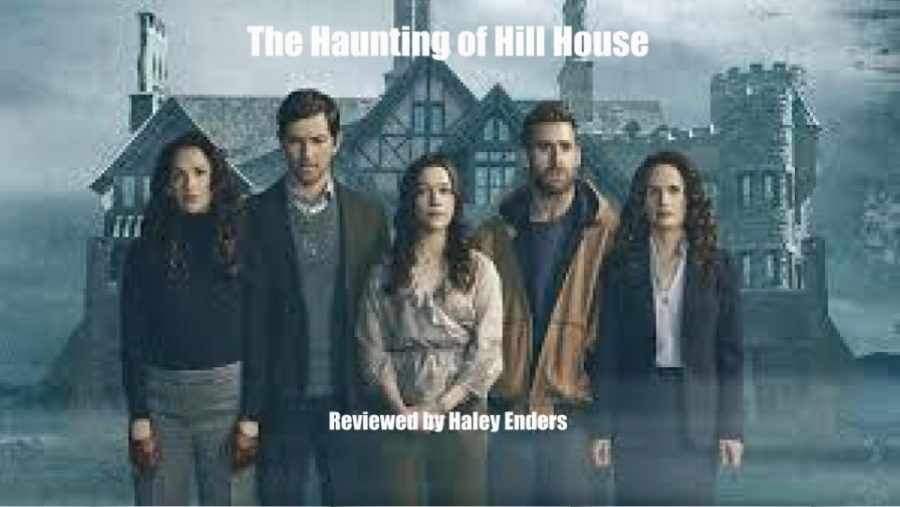Haunting of Hill House is not the horror you are looking for
Haley Enders reviews the disappointing Haunting of Hill House.
December 3, 2018
3.5/5 stars
Warning: Major spoilers
Mike Flanagan, the director of many popular thrillers such as Oculus, Hush, Before I Wake, and Gerald’s Game, slightly tainted his otherwise perfect career record with a new 10 episode Netflix series The Haunting of Hill House.
This show is based on the novel The Haunting of Hill House written by Shirley Jackson, and, yes, Shirley Crain (Lulu Wilson & Elizabeth Reaser) is named after the original author. The novel was praised by Stephen King, the master of horror, so much so he adapted the novel for film before Netflix even existed. Rose Red was a miniseries released in early 2002 and received much worse ratings and audience scores than the Netflix adaptation which was released on October 12, 2018.
“Mediocre” is the best word I can come up with to describe this show. The entire season is a whopping ten hours long. That’s enough time to read a whole book, walk a marathon, explore ten different escape rooms or even visit our nation’s capital. Any of those would have been a better use of my time than watching this show.
The show is filmed like a ten-hour movie. Every three episodes all wrap back to what happened one night: the night the Crain family fled Hill House. Every episode gives me another little clue or another glimpse into what occurred. Even from the first episode, the questions the entire series is based on are: What happened to the Crain’s mother, Olivia Crain (Carla Gugino)? Why won’t their father, Hugh Crain (Henry Thomas & Timothy Sutton) tell them what happened? And last, what makes that house so evil?
Don’t get me wrong, I think the plot is great. I don’t think the show is horrible, but I also don’t think it’s amazing.
I liked Netflix’s attempt to mind twist their audience with the whole concept of the Red Room. The Red Room is a room with a red door with no key to unlock it, and it isn’t drawn on the master blueprints to the house. So whoever drew the original blueprint either didn’t know it existed, or didn’t want anyone else to know it existed. This ties all the episodes together.
Because of the constant flashbacks, there’s a younger version and older version of each person, and each child actually resembles their future self. Directors rarely ever have them look alike but Mike Flanagan did.
Each character had a personal dilemma of their own (which all linked back to the Red Room and the house of course) which made viewers feel empathy for them. For instance, Theodora Crain, the second eldest sister (Kate Siegel), can feel through her hands. She’s almost like a psychic. She’s constantly wearing gloves so she doesn’t have to feel the same pain as the rest of her family. The oldest brother, Steven Crain (Michiel Huisman) is the author who writes about other people’s ghost stories, including his own, but doesn’t believe in ghosts. This leads to a lot of resentment towards him from his other siblings.
All the characters play their unique part perfectly: that of a sister losing her mind (Eleanor Crain played by Victoria Pedretti), a struggling addict (Luke Crain played by Oliver Jackson-Cohen), and a scared dad (Hugh Crain).
Overall, the actors played their parts superbly, even though they aren’t necessarily A-listers. Speaking of, if you’ve already seen the show, the man who plays younger Hugh Crain (Henry Thomas) may seem familiar. Thirty-six years ago he starred in a a film still popular to this day, E.T. the Extra-Terrestrial as Elliot.
The show constantly had me on the edge of my seat, biting my nails, anxious for what’s going to happen next. Every gruesome sight is preceded with the stereotypical music that raised my stress levels, preparing my body and mind for what’s to come. It’s comparable to the Jaws theme song.
Every jump scare is a complete surprise and is never expected. On “Episode 8: Witness Marks,” the Victoria Pedretti, who plays adult and the ghost of Eleanor “Nellie” Crain, was told to scare actresses Kate Siegel and Elizabeth Reaser mid-dialogue so their reactions would be more genuine.
The part I disliked most about the show which overshadowed all the good, was the ending. The whole Red Room idea was amazing, but it was super predictable, and I figured it out a little over halfway through the series. The telltale sign was the same long vertical window seen in the back.
According to Flanagan, the show’s end originally had a much darker ending, which I wish they kept so it’d be a little less boring, less conclusive, and left more room for the second season the producers are already planning. In the end, where the happy family is celebrating Luke Crain’s two year sobriety, Flanagan wanted to put the same identifying vertical window behind them, signifying they were all being tricked by the house again, and their happiness was simply a hallucination of the Red Room. But because the show had already put the audience through an emotional roller coaster, Flanagan decided against it because it was just “too cruel. The Crains have been through enough!”
Another thing about the ending was that it made everything that kept me up at night look like child’s play. The entire time everyone thought the house was possessed by some evil demons convincing people to harm themselves and others, it was just some manipulative, clinically insane spirit from the 1800s. It just ruined the entire vibe and made me feel stupid for ever flinching or covering my eyes.
The show was simply okay at best, but overall– disappointing. I wouldn’t recommend wasting your time on it. If you are though, watch it with the lights on.






